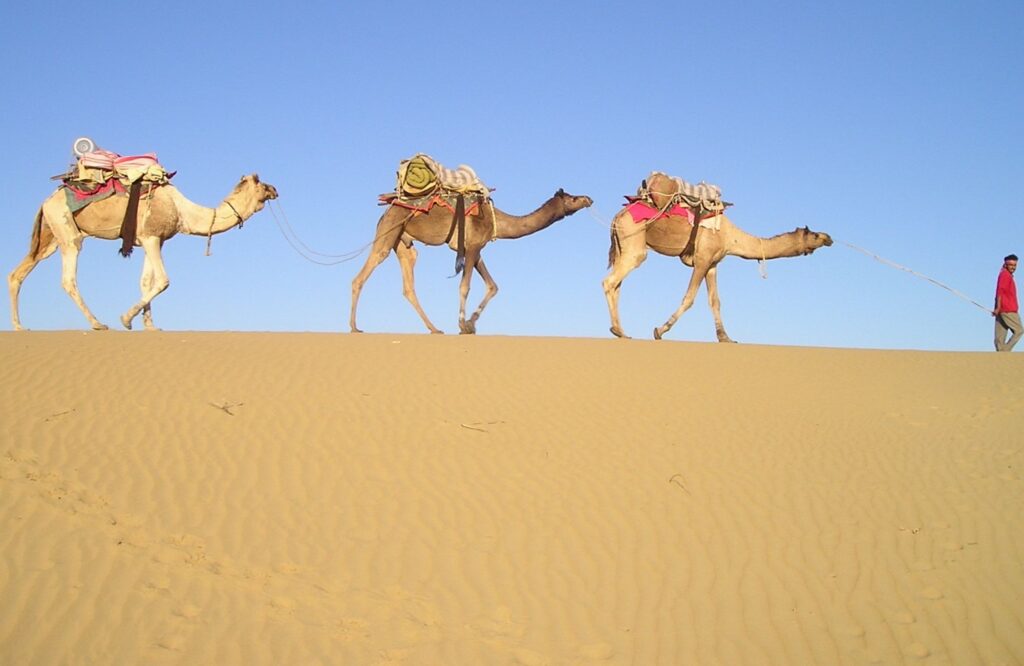Top 25 Places to Visit in India
India is a land where traditions, landscapes, and cultures blend into an extraordinary tapestry of experiences. From the snow-capped Himalayas in the north to the serene backwaters of Kerala in the south, each destination tells a story steeped in history and diversity. Whether you’re marvelling at ancient architectural wonders or soaking in the vibrant local festivals, this curated list of the top 25 places to visit in India will guide you towards an unforgettable journey.
The best time to explore most regions of India generally falls between October and March, when the weather is pleasant and skies are clear. It’s the perfect period to dive into the richness of India’s heritage, indulge in its culinary variety, and witness its natural beauty across different corners of the country. With this guide, you’ll know when and where to go to make the most of your Indian adventure.
The Golden Triangle: Delhi, Agra, and Jaipur
The Golden Triangle of India, connecting Delhi, Agra, and Jaipur, is a traveller’s dream come true. This mesmerising trio offers an unmatched blend of history, culture, and architecture, capturing the very essence of India’s rich heritage. Each city tells its own fascinating stories of empires past and presents experiences that appeal to every kind of traveller. Here’s what makes each destination unmissable.
Delhi: A Capital Blend of Ancient and Modern
Delhi, the political and cultural heartbeat of India, presents an intriguing juxtaposition of ancient history and contemporary vibrance. The city unfolds like a living museum, with every corner revealing stories of emperors, revolutions, and rebirth.
- India Gate: A towering archway standing as a testament to India’s war heroes, India Gate is iconic for its grandeur and the nightly illumination that adds a magical touch. Wander through the surrounding lawns, especially in the evenings.
- Qutub Minar: At 73 metres high, this UNESCO World Heritage Site remains a symbol of Indo-Islamic architecture. Its intricate carvings and historic significance make it a top contender for your itinerary.
- Humayun’s Tomb: Often considered a precursor to the Taj Mahal, this sandstone marvel embodies Mughal architectural elegance. The lush gardens here provide a serene respite from the city’s chaos.
- Chandni Chowk: Dive straight into a sensory overload at this bustling market. Whether you’re hunting for spices, jewellery, or Delhi’s famed street food, Chandni Chowk never disappoints.
Best Time to Explore: Visit Delhi between October and March when temperatures range from a cool 10°C to manageable 25°C. This weather is ideal for sightseeing and enjoying the city’s outdoor attractions. Summers can be unbearably hot, so plan accordingly.
Agra: The Epitome of Love and Mughal Grandeur
Agra, celebrated worldwide for its magnificent Taj Mahal, is more than just a romantic destination. It’s a treasure trove of Mughal history, architecture, and grandeur, whispering tales of majesty at every turn.
- The Taj Mahal: This eternal symbol of love, crafted from white marble, glows with a golden hue at sunrise and a silvery shine under the full moon. A UNESCO World Heritage Site, the Taj Mahal attracts millions each year, leaving every visitor awestruck with its beauty.
- Agra Fort: This red sandstone and marble fort served as the Mughal Empire’s main residence at its height. Walk through its palatial corridors to soak in the opulence and strategic brilliance of its construction.
- Fatehpur Sikri: Located just outside Agra, this stunning ancient city built by Akbar presents a harmonious blend of Persian, Islamic, and Indian architectural styles. The abandoned palaces hold both beauty and mystery.
Travel Tips for the Taj Mahal:
- Schedule your visit early in the morning to avoid crowds and witness the sunrise over the monument.
- Mondays are a no-go as the Taj Mahal is closed.
- Wear comfortable shoes, as you’ll be walking a lot within the complex.
Best Time to Explore: The prime months to discover Agra’s wonders are October to March, when the weather lends itself perfectly to outdoor exploration. Peak summers can exceed 40°C, making strolls around the monuments uncomfortable.
Jaipur: The Pink City’s Royal Charm
Vibrant and captivating, Jaipur is a city where history blends seamlessly with colour and culture. Its royal architecture, bustling bazaars, and warm hospitality ensure it remains a favourite among tourists.
- Amer Fort: Perched majestically on a hill, this fort offers stunning views and even more splendid interiors, from mirror halls to intricate frescoes. Don’t miss the light and sound show that takes you through the fort’s history.
- Hawa Mahal: This “Palace of Winds,” with its iconic, honeycomb-like façade, is a masterpiece of Rajput architecture. Built for royal ladies to observe city life discreetly, it’s a photographer’s delight.
- City Palace: A current royal residence, this expansive complex showcases artefacts, textiles, and paintings that narrate Jaipur’s opulent history.
- Jantar Mantar: This astronomical observatory is an ode to 18th-century scientific innovation. Admire its massive instruments that still function with remarkable precision.
Best Time to Explore: October to March is the perfect period to explore Jaipur, as the weather remains pleasant with temperatures between 15°C and 25°C. If you visit in January, you might catch the festive buzz of the Jaipur Literature Festival.
The Golden Triangle, with its three vibrant cities, offers a layered and immersive journey into India’s culture and history.
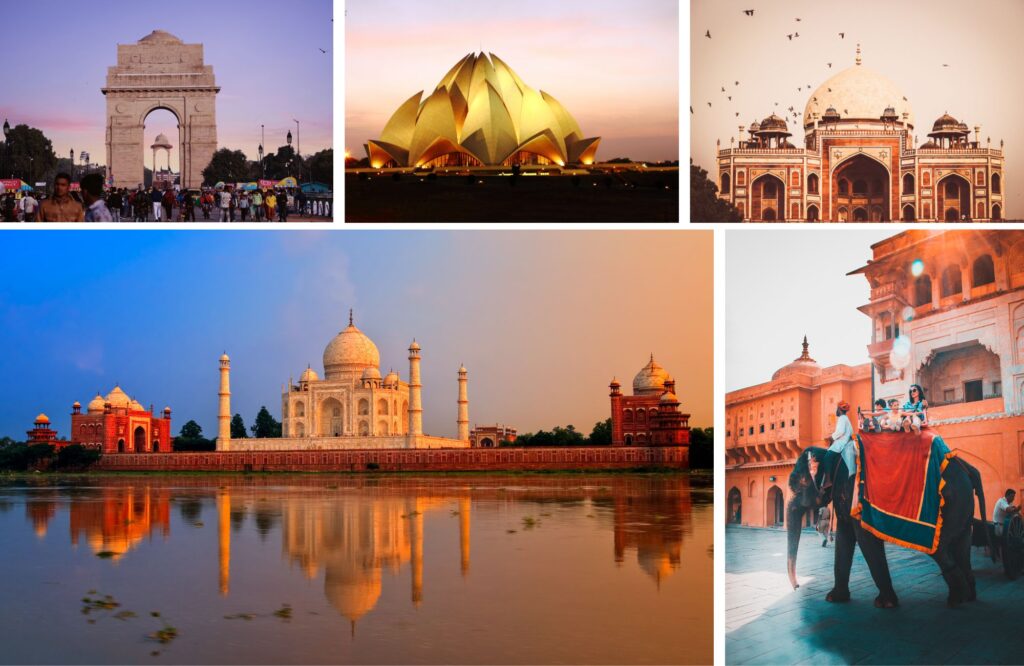
Rajasthan’s Desert Kingdoms: Jodhpur, Udaipur, and Jaisalmer
The vibrant state of Rajasthan is a land of kings, where history, culture, and landscapes come together to create a mesmerising travel experience. Among its many gems, the desert kingdoms of Jodhpur, Udaipur, and Jaisalmer shine the brightest, each offering a unique slice of royal heritage, architectural brilliance, and cultural charm. A journey through these cities feels like stepping into the pages of a grand historical epic.
Jodhpur: The Blue City
Nestled in the heart of the Thar Desert, Jodhpur instantly captures your imagination with its striking blue-washed houses, which give it the nickname, the “Blue City.” The city’s vibrant blue tones are thought to signify the homes of Brahmins and, over time, have become a tradition embraced widely.
- Mehrangarh Fort: Towering over the city on a rocky hill, Mehrangarh Fort is an imposing symbol of Jodhpur’s regal legacy. Explore its intricately carved palaces, winding courtyards, and a museum housing artefacts like royal palanquins, swords, and turbans. The views from the fort are breathtaking, with the blue maze of the old city stretching out below.
- Umaid Bhawan Palace: Built during the 20th century, this palace remains a testament to Rajasthan’s luxury and elegance. Part residence, part hotel, and part museum, it offers visitors an insight into royal life. Don’t miss the vintage car collection housed here.
- Cultural Experiences: Venture into the bustling Sardar Market to soak up local life, sample spicy mirchi vadas, and shop for exquisite handicrafts. For a more immersive experience, join a heritage walk through the old city or partake in a traditional block-printing workshop.
Best Time to Visit: October to March, when the desert sun softens, and the weather is perfect for exploration.
Udaipur: The City of Lakes
Known as one of the most romantic destinations in India, Udaipur enchants visitors with its shimmering lakes, majestic palaces, and the enduring charm of the Aravalli Hills. Often called the Venice of the East, the city blends natural beauty with human creativity.
- Lake Pichola: This serene lake is the centrepiece of Udaipur’s beauty. Take a boat ride at sunset to admire the reflections of the City Palace and Jag Mandir. The calm waters and surrounding architecture create an unmatched magical atmosphere.
- City Palace: Perched on the banks of Lake Pichola, this sprawling palace complex is a masterpiece of Rajasthani and Mughal styles. Its balconies, towers, and courtyards offer panoramic views of the city and lakes.
- Jag Mandir: This island palace in Lake Pichola is accessible by boat and is a haven of tranquillity. It is said to have inspired the Taj Mahal, and its gardens and marble pavilions are worth the visit.
- Romantic Ambiance: Wander through Saheliyon Ki Bari (Garden of Maidens) or enjoy an evening of folk dance and music at Bagore Ki Haveli. Udaipur is perfect for those seeking serene and romantic experiences.
Best Time to Visit: The winter months, from October to February, allow you to explore comfortably under the crisp skies.
Jaisalmer: The Golden City
Jaisalmer, rising like a mirage from the sandy expanse of the Thar Desert, is a treasure trove of medieval architecture, golden sandstone buildings, and thrilling desert experiences. The city’s charm lies in its timeless appeal and its ability to transport you to a bygone era.
- Jaisalmer Fort: Known as Sonar Quila or the Golden Fort, this UNESCO World Heritage Site is one of the few “living forts” in the world, still home to locals. Wander its narrow lanes, dotted with temples, havelis, and craft shops.
- Havelis: The ornately carved havelis, like Patwon Ki Haveli and Nathmal Ki Haveli, showcase intricate craftsmanship that stands as a testament to the wealth and artistry of the merchant class.
- Desert Safaris: Your visit to Jaisalmer is incomplete without a desert safari. Whether it’s a camel ride, a thrilling jeep safari, or camping under the stars amidst the dunes of Sam or Khuri, the experience is unforgettable. Evening safaris often include folk music and dance performances that bring the desert to life.
Best Time to Visit: From October to March, when the temperature is pleasant for outdoor adventures, and the golden sands seem even more inviting.
These desert destinations in Rajasthan offer a captivating mix of history, culture, and unforgettable moments. Whether you’re looking to explore ancient forts, marvel at palatial architecture, or lose yourself in the tranquillity of the desert, Jodhpur, Udaipur, and Jaisalmer promise experiences that linger long after your journey ends.
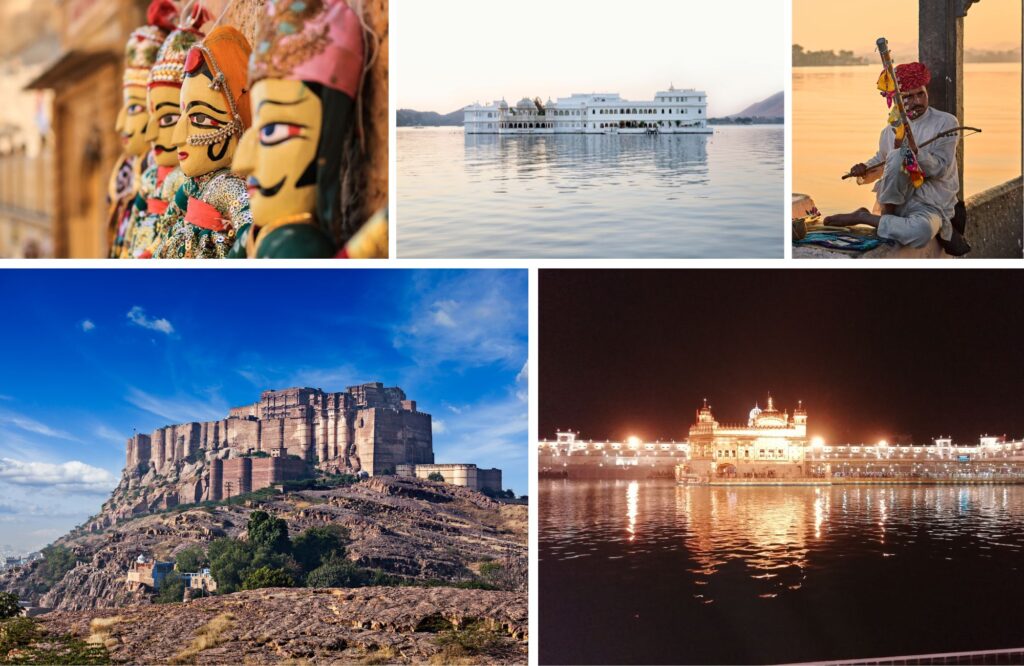
Kerala’s Backwaters and Beaches: Alleppey and Kovalam
Kerala, fondly known as “God’s Own Country,” is celebrated worldwide for its serene backwaters and pristine beaches. At the heart of this coastal paradise lie Alleppey and Kovalam, two destinations that capture the essence of Kerala’s natural beauty and cultural charm.
Alleppey (Alappuzha): The Venice of the East
Alleppey, or Alappuzha, is a picturesque town often referred to as the “Venice of the East” due to its intricate network of canals, shimmering lagoons, and sprawling paddy fields. The city’s crowning jewel is the backwaters – a tranquil stretch of interconnected waterways that lure travellers from all over the globe. Imagine gliding through these water highways aboard a houseboat, with coconut palms gently swaying in the breeze and the sound of rippling water lulling you into serenity.
- Houseboat Cruises: Traditional kettuvallams (houseboats), once used to transport local produce, have been transformed into floating homes complete with living areas, bedrooms, and on-board chefs. Whether you choose a day trip or an overnight stay, a houseboat journey offers endless views of lush greenery, small villages, and local life by the banks. Many also include freshly cooked Keralan meals, featuring specialties like fish curry and appam.
- Backwater Scenery: The backwaters are a perfect blend of natural beauty and cultural richness. Witness villagers fishing, children commuting to school in canoes, and women washing clothes alongside the waterways. The sight is a simple yet profound glimpse into a slower, more harmonious way of life.
- Unique Culture: Alleppey thrives on traditions and festivals. The annual Nehru Trophy Boat Race, held every August, is a thrilling celebration where snake boats race to cheering crowds. It’s a vibrant spectacle showcasing unity and competitiveness.
Best Time to Visit: The best season to explore the backwaters is the winter months, especially from November to February, when the humidity drops, and the weather stays pleasant with temperatures ranging from 17°C to 30°C. Avoid visiting during the monsoons, as heavy rains can limit your activities.
Kovalam: Coastal Paradise
Nestled along Kerala’s southern coast, Kovalam is a quintessential beach retreat combining stunning landscapes and a laid-back vibe. Known for its crescent-shaped beaches fringed with palm trees, Kovalam is a magnet for sunseekers and serenity lovers alike. Beyond its natural allure, it offers a rich cultural and wellness experience that makes every visit feel rejuvenating.
- Beaches: Kovalam stands out with its three distinct beaches—Lighthouse Beach, Hawa Beach, and Samudra Beach. Lighthouse Beach, the most iconic of the trio, is named after the 30-metre-tall Vizhinjam Lighthouse that towers over the coastline. Climbers are rewarded with panoramic views of the Arabian Sea and enchanting sunsets. Meanwhile, Hawa Beach is perfect for watching fishermen set sail in the early morning, and Samudra Beach provides a quieter escape from the crowds.
- Ayurvedic Treatments: Kovalam is a hotspot for wellness tourism, offering some of the finest Ayurvedic therapies in India. Many resorts and centres specialise in authentic Ayurvedic treatments, from rejuvenating massages to detox programs, incorporating traditional herbs and oils to restore balance to the mind and body.
- Local Culture: Aside from its beaches, Kovalam is home to lively markets selling handicrafts, spices, and souvenirs. You can also immerse yourself in cultural performances like Kathakali dance shows or join cooking classes to learn the secrets of Kerala’s lip-smacking cuisines.
Best Time to Visit: Kovalam is at its most inviting between November and February, with cool breezes and temperatures from 20°C to 32°C. The clear skies and calm seas make this the ideal season for sunbathing, swimming, and indulging in water sports. Avoid the monsoon season, which runs from June to September, as the rains can disrupt beach activities.
Kerala’s treasures, from Alleppey’s tranquil backwaters to Kovalam’s sparkling beaches, promise experiences that are as soothing as they are unforgettable. Whether you’re drifting through calm waters on a houseboat or basking under the tropical sun on golden sands, these destinations encapsulate the soul-soothing beauty of southern India.
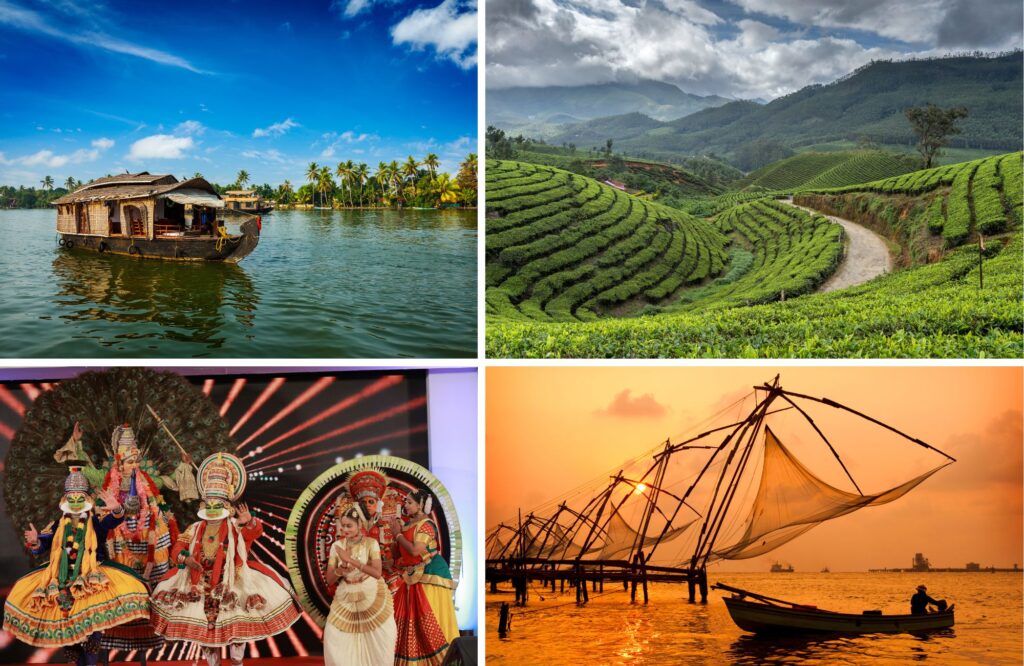
Spiritual Sanctuaries: Varanasi and Rishikesh
India, a land steeped in spirituality, offers a wealth of sacred spaces for those seeking peace and enlightenment. Among its many spiritual hubs, Varanasi and Rishikesh stand out as timeless destinations filled with profound meaning and serene beauty. These cities, set against the backdrop of the Holy Ganges and the foothills of the Himalayas, invite travellers to connect with their inner selves and experience traditions that have remained unchanged for centuries.
Varanasi: The City of Ghats
Varanasi, one of the oldest continuously inhabited cities in the world, is a profound spiritual epicentre for Hindus. Known as the “City of Ghats,” it rests on the banks of the sacred River Ganges and pulsates with a unique energy that blends devotion, culture, and history.
- The Mesmerising Ganga Aarti: Every evening, the ghats come alive with the Ganga Aarti, an awe-inspiring ritual held at Dashashwamedh Ghat. As dusk sets in, the rhythmic chanting of mantras, the glow of brass lamps, and the heady aroma of incense create an ethereal experience. This visually arresting ceremony is a tribute to Mother Ganga, with devotees offering flowers and lanterns to the river as a sign of reverence. To get the best view, consider watching the ritual from a boat on the Ganges — the shimmering reflections on the water are nothing short of magical.
- The Famous Ghats: The ghats of Varanasi are not just steps leading to a river; they are windows into a way of life. Assi Ghat, where many travellers begin their exploration, offers a tranquil morning scene often paired with yoga and chanting sessions. Manikarnika Ghat, on the other hand, is a revered cremation site, symbolising the cycle of life and death. Each ghat carries its own unique charm and significance, making a stroll along the riverside a must-do.
- Ancient Temples: The city houses countless temples that resonate with devotion. The Kashi Vishwanath Temple, dedicated to Lord Shiva, is the most iconic. Its golden spire gleams under the sun, welcoming pilgrims from around the world. Smaller yet equally fascinating shrines are tucked into narrow lanes, each narrating its own mythological tale.
Best Time to Visit: The ideal months to experience the spiritual essence of Varanasi are during winter, from November to February, when the cooler weather makes exploring the ghats and temples comfortable. Plus, the misty mornings lend an almost mystical aura to the city.
Rishikesh: The Yoga Capital
Nestled in the Himalayan foothills, Rishikesh is famously known as the “Yoga Capital of the World”. Here, spirituality flows as freely as the Holy Ganges, creating an environment perfect for introspection and self-discovery.
- Yoga Retreats and Ashrams: For yogis and seekers alike, Rishikesh is a paradise. The city boasts a plethora of renowned ashrams and yoga schools that cater to everyone from complete beginners to advanced practitioners. Parmarth Niketan Ashram and Sivananda Ashram offer structured programs in yoga, meditation, and self-healing. Many retreats balance physical practices like asana and pranayama with deeper teachings on mindfulness, philosophy, and Ayurveda, delivering a holistic experience. The International Yoga Festival held every March draws enthusiasts from all over the world.
- Adventures by the Ganges: Rishikesh is not just about spiritual calm; it offers excitement, too. Adventure seekers flock here for white-water rafting, which takes them on a thrilling ride through the Ganges’ rapids. You can also try bungee jumping, trekking to waterfalls like Neer Garh Waterfall, or simply stroll across the famous Laxman Jhula and Ram Jhula, suspension bridges that provide stunning views of the river and surrounding hills.
- The Sacred Ganges: At Triveni Ghat, the evening Aarti ceremony rivals Varanasi’s in its splendour, with lamps, chants, and floating diyas lighting up the night. For a more serene experience, find a quiet spot by the river early in the morning to meditate or watch the sunrise – the tranquillity is unmatched.
Best Time to Visit: The best time to experience Rishikesh is during the seasons of autumn and spring, specifically September to November and February to April. These periods offer pleasant weather, making outdoor and spiritual activities far more comfortable.
Both Varanasi and Rishikesh embody the spiritual soul of India. Whether you’re captivated by the timeless rituals of Varanasi or drawn to the tranquil, rejuvenating energy of Rishikesh, these sacred cities offer experiences that linger long after you leave their shores.
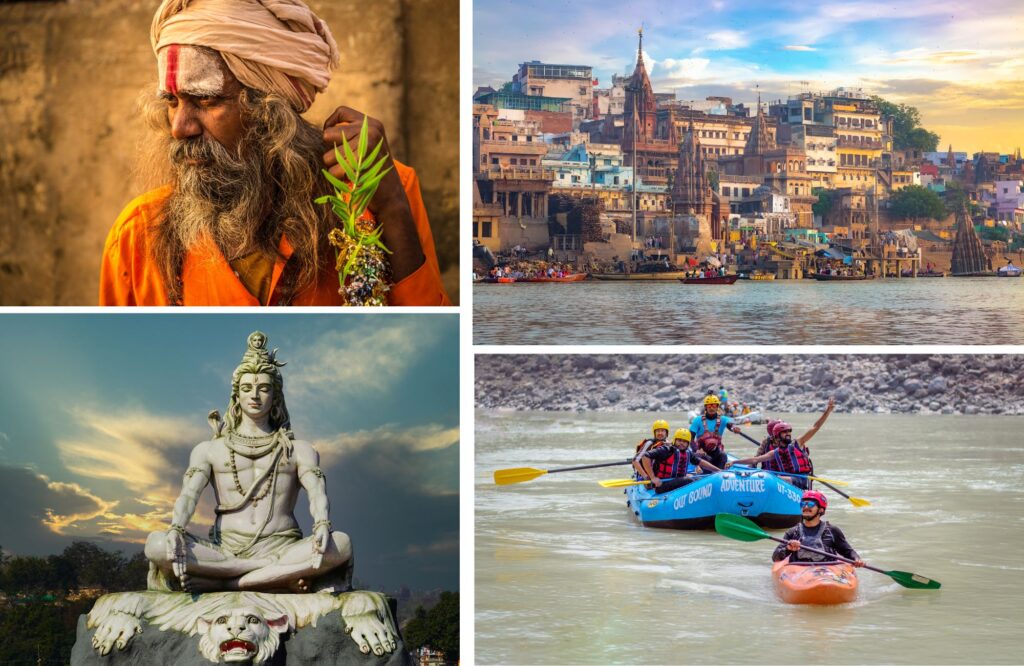
Hill Stations of India: Shimla and Darjeeling
India’s hill stations are an exquisite mix of natural beauty, history, and culture, offering travellers a serene escape from the hustle of city life. Among these, Shimla and Darjeeling stand out as landmarks of charm and nostalgia, each offering a distinctive experience surrounded by the majestic Himalayas.
Shimla: The Queen of Hills
Nestled in the heart of Himachal Pradesh, Shimla was once the summer capital of British India, and its colonial legacy is still evident today. Imagine walking along streets lined with mock-Tudor buildings, Gothic-style churches, and picturesque bungalows reminiscent of a bygone era. The appeal lies in its seamless blend of old-world charm and natural splendour.
- Colonial Architecture & The Mall Road
Shimla’s crowning jewel is The Mall Road, a lively promenade perfect for leisurely strolls. Lined with quaint cafes, local shops, and colonial structures, this stretch captures the town’s vibrant yet historic vibe. At the top sits the Christ Church, known for its neo-Gothic architecture and colourful stained glass windows. - Scenic Views & Jakhoo Hill
Surrounded by lush cedar and pine forests, Shimla offers breathtaking views of the snow-capped Himalayas. A short climb (or cable car ride) to Jakhoo Hill, the highest point in Shimla, rewards you with panoramic landscapes and the famous Jakhoo Temple, home to an imposing Hanuman statue towering above the treetops. - The Shimla-Kalka Toy Train
A UNESCO World Heritage Site, the Shimla-Kalka Toy Train is an unforgettable journey. Winding through 102 tunnels and crossing scenic bridges, this train ride offers a whimsical tour of the region’s natural beauty. It’s a treat for photographers, nature lovers, and nostalgia seekers alike.
Best Time to Visit: Visit Shimla during March to June for mild, pleasant weather perfect for outdoor walks. The months of September to November, just post-monsoon, bring clear skies and verdant surroundings. Avoid the peak winter season unless you’re looking for snow-filled adventures.
Darjeeling: The Land of Tea
Perched in the Eastern Himalayas of West Bengal, Darjeeling is a treasure trove of natural beauty, tea plantations, and cultural charm. Known as the “Queen of the Hills,” it beckons travellers with its picturesque backdrops and refreshing mountain air.
- Tea Gardens & Local Flavours
Darjeeling is synonymous with tea. Sprawling tea estates, such as Happy Valley or Glenburn, stretch across the hills, offering guided tours that reveal the art of tea cultivation. Sipping a freshly brewed cup while overlooking these lush plantations is a quintessential Darjeeling experience. - Himalayan Views & Tiger Hill
For an ethereal sunrise, head to Tiger Hill, where the first rays of sunlight illuminate the mighty Kanchenjunga. On a clear day, you might even catch a glimpse of the distant Everest in all its glory. It’s a sight so captivating that it seems like nature’s own symphony. - Darjeeling Himalayan Railway
Like Shimla, Darjeeling has its very own Himalayan Toy Train, a UNESCO World Heritage Site. This narrow-gauge railway winds through serene villages, green hills, and gurgling streams, delivering a slice of old-world magic. The iconic steam engine pulling its tiny coaches is a delight for kids and adults alike.
Best Time to Visit: The months from March to May and September to November are ideal. During these periods, the weather is invigorating, and the skies are mostly clear for those iconic Himalayan views. Monsoon seasons can obscure the vistas and bring heavy rains, while winter temperatures are chilly but manageable for those who love cosy layers.
Shimla and Darjeeling both encapsulate the mystique of the Himalayas in their unique ways, offering experiences that strike the perfect balance between history, relaxation, and adventure. Choose one—or both—for your itinerary, and let these hill stations weave their magic.
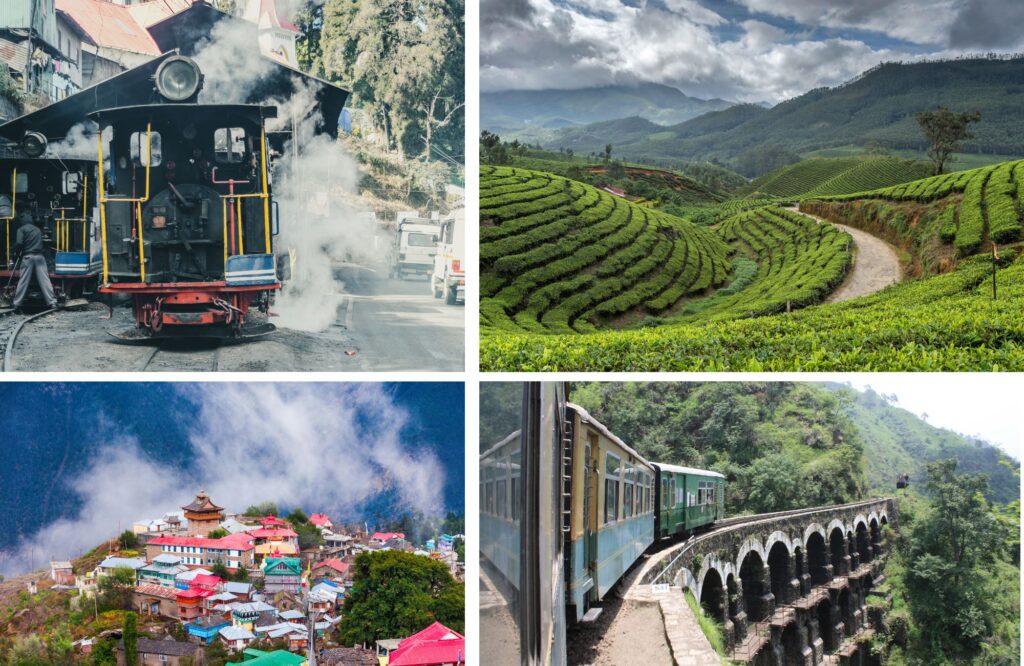
Goa’s Beaches and Nightlife: North and South Goa
Goa, synonymous with golden sandy beaches and vibrant nightlife, is a destination that truly offers two distinct vibes depending on where you decide to go. Whether you’re seeking pulsating parties or a peaceful retreat, Goa’s dual nature — as seen in the dynamic energy of North Goa and the serene charm of South Goa — ensures the perfect getaway for every kind of traveller.
North Goa: Beaches and Parties
North Goa thrives on its reputation for being the beating heart of entertainment, where the beaches are alive with activity long after the sun has set. If you’re looking to immerse yourself in the livelier side of Goa, this is where you want to be.
- Baga Beach: Considered the most popular beach in Goa, Baga is synonymous with excitement. From thrilling water sports during the day to nightclubs like Tito’s and Café Mambo lighting up the area after dark, Baga is where Goa’s party spirit truly shines.
- Calangute Beach: Lovingly called the “Queen of Beaches,” Calangute combines natural beauty with an endless parade of beach shacks, restaurants, and shopping stalls. It’s a great spot to sip cocktails, hear live music, or simply indulge in some people-watching.
- Anjuna Beach: Known for its hippie roots and iconic Wednesday Flea Market, Anjuna has a bohemian vibe. As dusk falls, psychedelic trance parties take over, especially during peak season.
- Nightlife Vibes: Clubs like Hilltop and Curlies draw travellers from all over the world. North Goa’s nightlife spans everything from beachside bars to neon-lit discos — perfect for those who don’t mind dancing till sunrise.
Best Time to Visit: The bustling atmosphere of North Goa is at its best during the months of November to February. With cool, breezy evenings and minimal rain, this is the ideal time to explore outdoor music gigs, international festivals like Sunburn, and lively beach parties.
South Goa: Serenity and Relaxation
In contrast to the loud, energetic pulse of the north, South Goa moves to its own quiet rhythm. Perfect for those looking to relax, unwind, and connect with nature, South Goa’s beaches are unspoiled sanctuaries of calm.
- Palolem Beach: Lined with swaying palm trees and colourful shacks, Palolem is picture-perfect tranquility. It’s one of the best places to lounge with a book, go kayaking, or enjoy candlelit dinners by the shore.
- Agonda Beach: Ranked as one of India’s cleanest beaches, Agonda offers a pristine escape. Horses graze on its soft sands, and the absence of commercialisation makes it a stunning spot for solitude or yoga retreats.
- More Than Just Beaches: Beyond the sands, tuck into traditional Goan seafood at neighbourhood joints, or explore charming villages where life slows down. Nearby, Cabo de Rama Fort offers a slice of history paired with spectacular sunset views.
Best Time to Visit: Much like the north, the best months for South Goa are November to February, when the weather is pleasantly mild, and the beaches are at their most picturesque. With fewer crowds compared to its northern counterpart during this time, you’ll also enjoy ultimate peace and privacy.
In Goa, you don’t have to choose between energetic nights and lazy days — you can have both, depending on where you look. Whether North Goa’s party atmosphere speaks to your wild side or South Goa’s serene beaches call for a soul-soothing retreat, Goa’s diversity makes it one of India’s most versatile destinations.
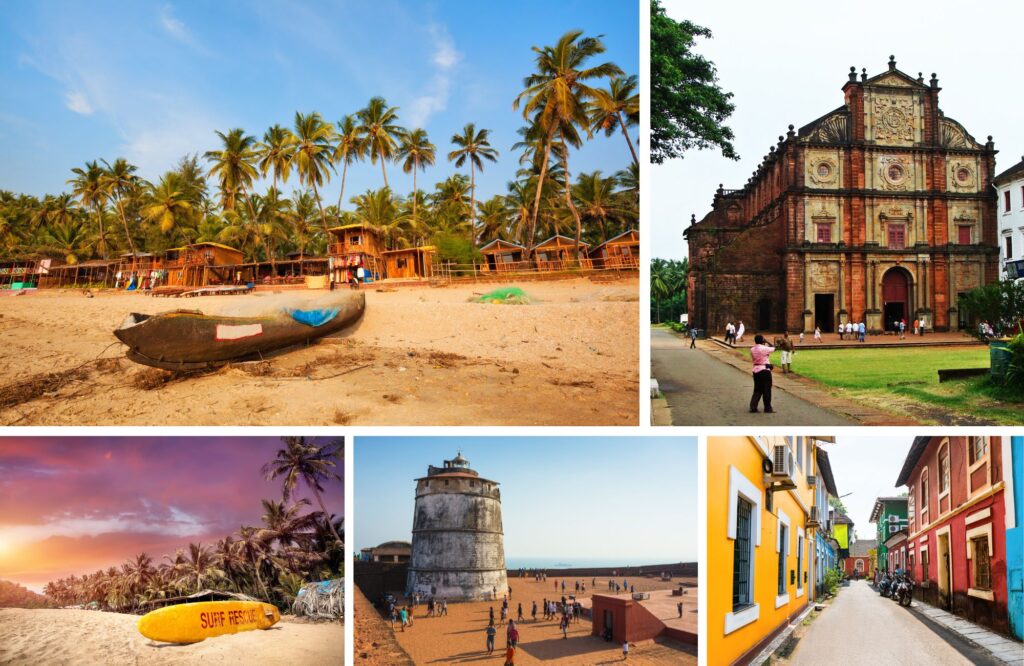
Temples of Tamil Nadu: Madurai and Chennai
Tamil Nadu, the land of temples and timeless heritage, hosts some of the most breathtaking and historically significant sites in India. Among these, the cities of Madurai and Chennai stand out for their unparalleled spiritual, cultural, and architectural landmarks. Whether you seek a divine connection, a taste of vibrant local culture, or a peek into history, these cities have something to offer.
Madurai: The Temple City
Madurai, often referred to as the “Athens of the East,” is a city where history and spirituality converge. It is one of India’s oldest cities, and its culture and daily life are deeply intertwined with the iconic Meenakshi Amman Temple. The bustling streets surrounding the temple compound tell tales of rich traditions, lively festivities, and enduring devotion.
- Meenakshi Amman Temple:
This masterpiece of Dravidian architecture is a sprawling temple complex built around 2,500 years ago, dedicated to Goddess Meenakshi (an incarnation of Parvati) and Lord Sundareswarar (an incarnation of Shiva). Its towering gopurams (gateway towers) are adorned with colourful, intricate carvings of gods, demons, and mythical creatures, drawing visitors from around the world. Inside, the temple features massive pillared halls, serene sanctums, and the sacred Golden Lotus Tank, which lends an almost surreal charm to the spiritual experience. The temple hosts grand festivals, with the annual Meenakshi Tirukalyanam festival attracting thousands of devotees. - Vibrant Culture:
Just outside the temple, you’ll find bustling markets brimming with fresh flowers, vibrant textiles, and handcrafted souvenirs. The locals’ warm hospitality, colourful attire, and traditional Tamil cuisine—featuring dosas, idlis, and fragrant sambars—add layers of charm to this ancient city.
Best Time to Visit:
Plan your trip between November and February, when the weather is cooler and allows for comfortable exploration. The winter months also coincide with several temple festivals, giving you the chance to witness Madurai’s cultural vibrancy at its peak.
Chennai: Gateway to the South
Chennai, Tamil Nadu’s capital, is a dynamic city that effortlessly blends historical significance with a thriving modern culture. While it may seem fast-paced, Chennai’s soul can be discovered through its tranquil temples, historic landmarks, and vibrant coastal life.
- Fort St. George:
This historical landmark, established in 1644 by the British East India Company, is more than just a fort; it symbolises the onset of colonial influence in south India. Home to a museum rich with artefacts, paintings, and letters from the British era, its strong walls and quaint architecture stand in stark contrast to the bustling city outside. History buffs will find themselves captivated by its tales of trade and empire. - Marina Beach:
One of the world’s longest urban beaches, Marina Beach is the heart and soul of Chennai’s coastal charm. During the early mornings, the sight of fishermen heading out to sea and joggers enjoying the soft sands creates a lively yet relaxing ambience. At sunset, the beach transforms into a carnival of vendors selling roasted peanuts, local ice creams, and refreshing coconut water—perfect for soaking in the scenic views. - Cultural Scene:
Chennai’s cultural richness is palpable everywhere. Visit Kapaleeshwarar Temple, a fine example of Tamil Hindu architecture, or stroll through the historic Mylapore neighbourhood, known for its traditional houses and vibrant local markets. For performing arts enthusiasts, Chennai’s December music season (Margazhi Festival) is a treat, offering Carnatic music and Bharatanatyam dance performances.
Best Time to Visit:
Like Madurai, Chennai is best visited during November to February, when the weather is pleasant, allowing you to explore the sights without the sweltering summer heat. Beach lovers, in particular, will enjoy the breezy coastal evenings during this time.
By choosing Tamil Nadu’s iconic towns of Madurai and Chennai, you’ll discover an intricate tapestry of spirituality, history, and culture that leaves a lasting impression.
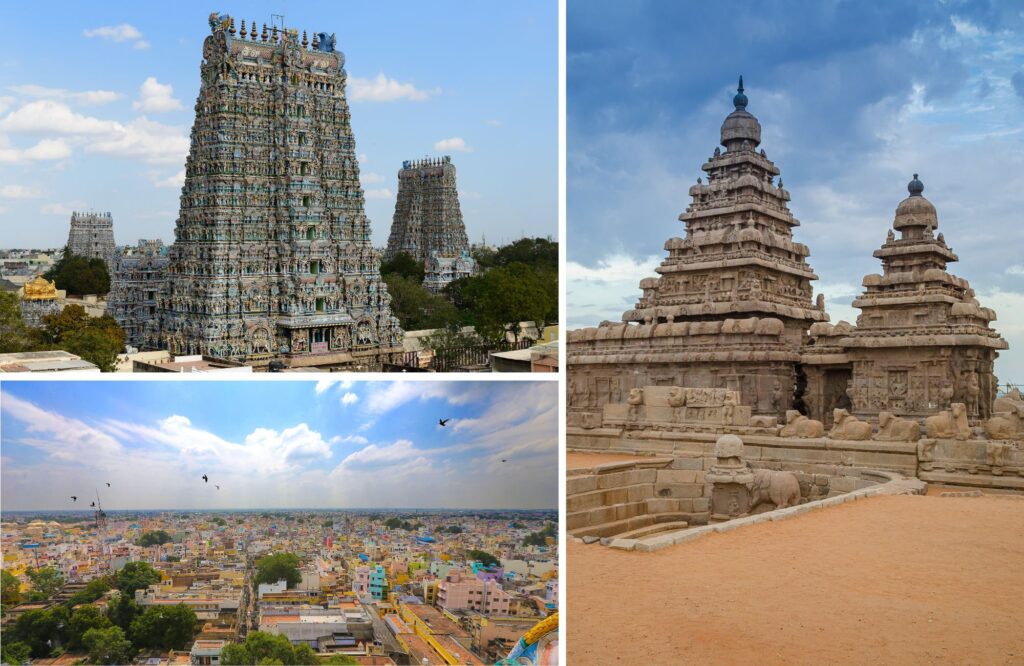
Other Notable Destinations in India
India is a vast treasure trove of destinations, with every corner offering unique experiences that reflect the nation’s rich tapestry of culture, history, and nature. Outside the famed cities and regions, lesser-highlighted yet equally mesmerising places await exploration. Whether you’re captivated by historical grandeur, natural beauty, or spiritual serenity, there’s always something new to discover in this endlessly diverse country.
Amritsar: The Spiritual Heart of Punjab
Amritsar is a city where reverence and resilience converge, making it a must-visit destination in northern India. Known as the spiritual hub of Sikhism, it’s here that you’ll find one of India’s most iconic landmarks.
- Golden Temple (Harmandir Sahib): The crown jewel of Amritsar, the Golden Temple is a luminous sanctuary of peace amidst the bustling city. Its golden façade shimmers in the centre of a sacred water tank, exuding tranquillity. Visitors are welcomed with open arms and free meals at the temple’s langar (community kitchen), which epitomises inclusivity and service.
- Jallianwala Bagh: Just a short walk from the temple, this poignant memorial commemorates the tragic massacre of 1919. The garden and its preserved bullet marks stand as a quiet tribute to India’s fight for independence.
- Wagah Border Ceremony: A high-energy display of patriotism and camaraderie, the border-closing ceremony between India and Pakistan at Wagah is a spectacle of synchronised marches and energetic cheers.
Best Time to Visit: Amritsar is best explored during the months of November to March, offering cooler and more pleasant weather, ideal for walking tours.
Khajuraho: A Celebration of Art and Spirituality
Nestled in Madhya Pradesh, Khajuraho is renowned worldwide for its UNESCO-listed temples adorned with intricate carvings. These temples are masterpieces of art, showcasing a unique blend of sensuality and spirituality.
- Khajuraho Temples: A group of 22 surviving temples, out of an original 85, is dedicated to Hindu and Jain deities. Their exquisite sculptures depict not just gods and goddesses but also beautifully detailed scenes of everyday life, celebrations, and human connections. The Kandariya Mahadeva Temple is a highlight, with its towering spire and intricate erotic art that speaks to the openness of ancient Indian society.
- Light and Sound Show: A fascinating evening show recounts the history and significance of the temples against the backdrop of their illuminated grandeur, blending storytelling with visual magic.
Best Time to Visit: Winter is the best time to visit Khajuraho, from October to February, when the cool climate allows for laid-back exploration of this open-air gallery.
Hampi: A Forgotten Empire
Hampi, located in Karnataka, is not just a destination but a journey into the past. Once the flourishing capital of the Vijayanagara Empire, this sprawling UNESCO World Heritage Site is nestled amidst surreal boulder-strewn landscapes.
- Vittala Temple and Stone Chariot: A symbol of Hampi, the intricately carved stone chariot and the spectacular Vittala Temple, with its musical pillars, are a must-see.
- Virupaksha Temple: Dedicated to Lord Shiva, this living temple has been a centre of worship since the 7th century. Its towering gopuram dominates the skyline, welcoming visitors and pilgrims alike.
- Hampi Bazaar and Riverside Ruins: Wander through the ancient market streets and explore the beautifully preserved sculptures along the riverbanks, which offer glimpses into Hampi’s glorious past.
Best Time to Visit: Visit during November to February for the most friendly weather, perfect for exploring the open ruins and hilly terrain.
Andaman Islands: A Tropical Paradise
Far from the mainland, the Andaman Islands offer an escape into pristine natural beauty, crystal-clear waters, and abundant marine life. This archipelago in the Bay of Bengal is a dream for beach lovers and adventurers.
- Radhanagar Beach: Frequently listed among Asia’s best beaches, Radhanagar on Havelock Island is a haven of powdery white sands and turquoise waters, ideal for a leisurely day.
- Scuba Diving and Snorkelling: The islands’ coral reefs are teeming with vibrant marine species, offering some of the best underwater experiences in India at locations like Neil Island and Baratang.
- Cellular Jail: Known as Kala Pani during colonial rule, this historic jail in Port Blair reflects the hardships endured by India’s freedom fighters. The evening Light and Sound Show reveals moving stories of bravery and sacrifice.
Best Time to Visit: The islands are at their finest between November and April, avoiding monsoon rains for the perfect tropical experience.
Rann of Kutch: The White Desert of India
In Gujarat, the Rann of Kutch unveils an otherworldly spectacle—a sprawling salt desert that stretches across the horizon. This natural wonder becomes magical under a full moon, with the endless expanse of white sands glistening in the moonlight.
- Kutch Festival (Rann Utsav): Held annually from November to February, this vibrant festival transforms the desert into a mosaic of music, dance, handicrafts, and local cuisine. Visitors can stay in luxurious tented accommodations to experience the desert’s charm fully.
- Wildlife at Kutch: Nearby sanctuaries like the Indian Wild Ass Sanctuary and Chari-Dhand Wetland attract birdwatchers and wildlife enthusiasts with exotic species such as flamingos and wild asses.
Best Time to Visit: The desert is most captivating during the festival months, from November to February, combining cultural richness with breathtaking landscapes.
Shillong and Cherrapunji: The Beauty of Meghalaya
Tucked away in northeast India, Meghalaya is home to lush green hills, cascading waterfalls, and mysterious caves. Known as the “Abode of Clouds,” this region feels like stepping into another realm entirely.
- Shillong: Often called the “Scotland of the East,” Shillong charms visitors with its quaint cafes, bustling markets, and sweeping views from Shillong Peak. Don’t miss the Umiam Lake, a tranquil spot for picnicking and boating.
- Cherrapunji (Sohra): One of the wettest places on earth, Cherrapunji rewards visitors with jaw-dropping sights like the Nohkalikai Falls and the stunning root bridges—living tree roots braided into natural suspension pathways over decades.
- Mawsmai Caves: For adventure-seekers, these limestone caves provide an exciting underground trek through tight passages and glimmering stalactites.
Best Time to Visit: The ideal period is October to April, after the monsoons have revived the lush greenery but rains have tapered off for easy travel.
These lesser-explored destinations are a testament to India’s astounding diversity. With a mix of cultural landmarks, serene landscapes, and unforgettable adventures, they offer experiences that go beyond the ordinary.
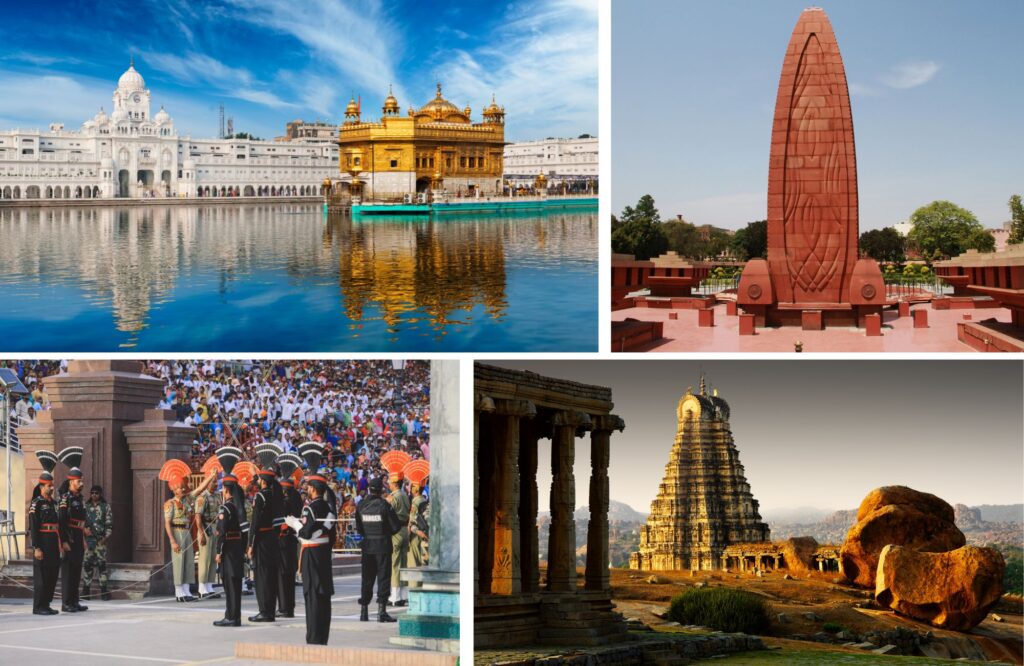
Planning Your Trip to India: Tips and Considerations
India is a vast and diverse country that can feel overwhelming for first-time visitors, but with the right preparation, your journey can be both smooth and deeply rewarding. From bustling cities rich in history to serene mountains and coastal retreats, planning is key to making the most of your trip. Below, we break down critical factors to consider when organising your Indian adventure.
Understanding Visa Requirements
Before your trip, you’ll need to sort out your visa. Most travellers require a visa to enter India, with e-Visa options available for shorter stays. The process is relatively straightforward but plan ahead, applying at least 4 to 120 days before your intended arrival. Ensure your visa covers your planned duration and entry points, as overstaying can lead to complications.
If you’re flying into key international hubs such as Delhi, Mumbai, or Bengaluru, applying for the e-Visa will likely be the most convenient option. Double-check the type of visa you need if you’re planning extended stays or multiple entries, especially if venturing to neighbouring countries like Nepal or Bhutan.
Health and Safety Precautions
When travelling to India, considering your health and safety is paramount. Consult with a healthcare professional 6–8 weeks before travelling to get necessary vaccinations such as those for hepatitis A and typhoid. If you’re planning to visit rural areas or regions with a risk of malaria (such as the northeast or around Mangalore), pack anti-malarial tablets and carry mosquito repellent.
Drinking tap water is a no-go in most parts of India. Stick to bottled or purified water and avoid ice in drinks from street vendors. Carry a portable water purifier or use water purification tablets if you plan to travel off the beaten path. For emergencies, note that medical services in private hospitals tend to be more reliable than public facilities, so travel insurance that covers healthcare is a must.
Timing Your Visit: The Best Seasons
India is a land of varied climates, so timing your visit depends on where you want to go. For most regions, the cooler months from October to March provide the best conditions, with pleasant weather that’s ideal for sightseeing. However, if you’re heading to the Himalayas or northern hill stations, April to June is a fantastic time to visit before the monsoon rains arrive. The monsoon season, generally from July to September, can make travel tricky, but it’s also the perfect time to see southern destinations like Kerala at their lushest.
Packing Essentials
Packing smartly for India can make your trip infinitely easier. Here’s a quick checklist of essentials:
- Light, breathable clothing: Cotton or linen works best in the warm and humid climate. For women, long skirts or salwar kameez are comfortable and culturally appropriate.
- Power adapter: India uses type D electrical sockets, so bring the correct international adapter.
- Comfortable shoes: Perfect for exploring uneven roads, temples, and crowded markets.
- Travel insurance: Covering medical emergencies, flight cancellations, and lost belongings.
- Medications: Include traveller’s diarrhoea tablets, a basic first-aid kit, and bug spray.
- Reusable water bottle: Preferably one with a filter to avoid single-use plastics.
Pre-Booking and Budgeting Tips
If you plan to visit popular spots like the Taj Mahal or Jaipur during peak tourist months, book tickets for hotels and train rides well in advance. Indian trains are an experience in themselves, but they also fill up quickly, so use platforms like IRCTC or local travel agents to secure your reservation. Similarly, domestic flights within India are budget-friendly and can save valuable time; airlines such as Indigo and SpiceJet often run year-round promotions.
While India is known for being affordable, it’s wise to carry a mix of cash and digital payment options. ATMs are available in most cities and towns, but small vendors and auto-rickshaws often only accept cash. Apps like Paytm and Google Pay are widely used in urban areas and offer a more secure way to pay.
Cultural and Social Considerations
India’s rich culture is reflected in its traditions, etiquette, and daily life, which can be quite different for many visitors. Here are a few cultural tips to keep in mind:
- Dress modestly: Especially when visiting temples or rural areas. Covering shoulders and knees is a sign of respect.
- Respect religious customs: Always remove your shoes before entering temples or mosques, and avoid touching holy statues.
- Greeting locals: A friendly “Namaste” (with your hands pressed together) goes a long way in bridging cultural gaps.
- Gender Awareness: Women travellers should exercise caution, avoid travelling alone late at night, and stick to well-lit public spaces.
Additionally, be prepared for India’s lively pace – from chaotic traffic to crowded markets, embracing the buzz is part of the adventure. Approach situations with patience and a sense of humour, and you’ll find yourself adjusting in no time.
Handling Transportation
Navigating India’s transportation system can be an adventure on its own. While auto-rickshaws, taxis, and metro systems are readily available in bigger cities, long-distance travel is often done by trains or buses. Ride-hailing apps like Ola and Uber make urban commutes easy and are widely available in major cities. For rural destinations or offbeat paths, hiring a private car and driver could be a safer and more efficient option.
Be cautious when crossing roads – India’s traffic can be chaotic by Western standards! A tip? Stick close to locals; they have a knack for timing it right.
Food and Street Smarts
India is a paradise for food lovers, but it’s wise to tread carefully with street food if you’re not used to the spices or preparation methods. Look for busy stalls with a high turnover – the food is more likely to be fresh and safe. Opt for cooked dishes over raw salads or chutneys and carry hand sanitiser for peace of mind.
Feeling adventurous? Try the chaat (savoury snacks) in Delhi, dosa in South India, or milk-based sweets like rasgulla in Kolkata. Embrace the differences, but listen to your body.
Planning ahead means you’ll get to focus less on logistics and more on taking in the dazzling beauty and diversity of India.
Conclusion
India is a destination that captivates with its boundless diversity, blending historical significance, natural wonders, and vibrant cultures across every region. Whether you’re drawn to the serene backwaters of Kerala, the majestic Himalayas, or the architectural brilliance of Rajasthan, each corner of the country promises something extraordinary.
The best time to explore India falls between October and March, offering pleasant weather for most regions. Tailor your journey to the seasons and your interests—be it festivals, wildlife adventures, or historical exploration—to make the most of your visit.
Take the plunge into this remarkable country where every day reveals a new story. Start planning your unique adventure, pack your curiosity, and let India leave you with memories that will stay for a lifetime. Let your journey begin.
For private escorted holiday to India visit RendzvousRoadtrips.com
Fancy a horse riding adventure in India?

